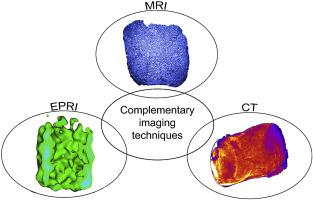当前位置:
X-MOL 学术
›
Solid State Sci.
›
论文详情
Our official English website, www.x-mol.net, welcomes your
feedback! (Note: you will need to create a separate account there.)
CT, MR and EPR imaging of graphene oxide aerogels
Solid State Sciences ( IF 3.4 ) Pub Date : 2020-11-01 , DOI: 10.1016/j.solidstatesciences.2020.106402 Krzysztof Tadyszak , Beata Wereszczyńska , Michał Gonet
Solid State Sciences ( IF 3.4 ) Pub Date : 2020-11-01 , DOI: 10.1016/j.solidstatesciences.2020.106402 Krzysztof Tadyszak , Beata Wereszczyńska , Michał Gonet

|
Abstract The shape and intrinsic pore structure of pristine and partially reduced graphene oxide (prGO) aerogels/hydrogels was imaged using three complementary techniques: Magnetic Resonance Imaging (MRI), Computer Tomography (CT) and Electron Paramagnetic Resonance Imaging (EPRI). Each method is sensitive to different features of the sample: CT images are contrasted with mass density changes across sample, MRI with hydrogen density, nuclear relaxation times, diffusion, and finally EPRI with radical density. The complementarity of the techniques is presented on exemplary chosen prGO aerogels, which are currently researched for variety of applications, such as biomaterials in tissue engineering. All techniques have their strengths and weaknesses which are thoroughly pointed out and discussed. EPRI technique, which has been perfected only during last years, is used here for the first time to image carbon-based foams. Finally scanning electron microscopy (SEM) equipped with energy dispersive X-ray spectroscopy (EDS) is used to characterize surface and elemental content of fabricated prGO aerogels/hydrogels.
中文翻译:

氧化石墨烯气凝胶的 CT、MR 和 EPR 成像
摘要 原始和部分还原氧化石墨烯 (prGO) 气凝胶/水凝胶的形状和内在孔结构使用三种互补技术进行成像:磁共振成像 (MRI)、计算机断层扫描 (CT) 和电子顺磁共振成像 (EPRI)。每种方法都对样本的不同特征敏感:CT 图像与样本中的质量密度变化进行对比,MRI 与氢密度、核弛豫时间、扩散进行对比,最后是 EPRI 与自由基密度的对比。这些技术的互补性体现在示例性选择的 prGO 气凝胶上,这些气凝胶目前正在研究各种应用,例如组织工程中的生物材料。所有技术都有其优点和缺点,它们都被彻底指出和讨论。EPRI技术,仅在去年才得到完善,在这里首次用于对碳基泡沫进行成像。最后,配备能量色散 X 射线光谱 (EDS) 的扫描电子显微镜 (SEM) 用于表征制造的 prGO 气凝胶/水凝胶的表面和元素含量。
更新日期:2020-11-01
中文翻译:

氧化石墨烯气凝胶的 CT、MR 和 EPR 成像
摘要 原始和部分还原氧化石墨烯 (prGO) 气凝胶/水凝胶的形状和内在孔结构使用三种互补技术进行成像:磁共振成像 (MRI)、计算机断层扫描 (CT) 和电子顺磁共振成像 (EPRI)。每种方法都对样本的不同特征敏感:CT 图像与样本中的质量密度变化进行对比,MRI 与氢密度、核弛豫时间、扩散进行对比,最后是 EPRI 与自由基密度的对比。这些技术的互补性体现在示例性选择的 prGO 气凝胶上,这些气凝胶目前正在研究各种应用,例如组织工程中的生物材料。所有技术都有其优点和缺点,它们都被彻底指出和讨论。EPRI技术,仅在去年才得到完善,在这里首次用于对碳基泡沫进行成像。最后,配备能量色散 X 射线光谱 (EDS) 的扫描电子显微镜 (SEM) 用于表征制造的 prGO 气凝胶/水凝胶的表面和元素含量。









































 京公网安备 11010802027423号
京公网安备 11010802027423号